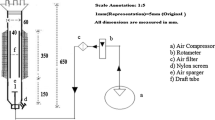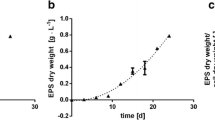Abstract
The production of recombinant glycoproteins in Dictyostelium discoideum by conventional cell culture methods was limited by low cell density as well as low growth rate. In order to achieve high cell density cultivation, polyurethane foam (PUF) with high porosity was introduced as new matrix for the immobilization of D. discoideum. The results showed that about 88–93% cells of D. discoideum were adsorbed onto the PUF particles after 100 min equilibrium between adsorbed and free cells, and the highest immobilization rate was achieved by adding the same quantity of PUF matrix with the thin cylinder style. Furthermore, polyurethane foam was used as the immobilization matrix in a rotating PUF-bed bioreactor system. With batch cultures in the rotating bed bioreactor, the concentration of immobilized cells in the PUF carrier increased to 4.2 × 107 cells ml−1 after 167 h cultivation, which was about fourfold higher than the maximal cell density in the conventional free-cell culture. Further studies showed that the cells of D. discoideum were not just simply adsorbed on the surfaces, but actively attached to the surfaces through their network of pseudopodia or filopodia. The present work is very promising to improve the productivity of recombinant proteins in D. discoideum with high cell density in this novel rotating bed bioreactor.






Similar content being viewed by others
References
Beshay U, Friehs K, Azzam AEM, Flaschel E (2003) Cultivation of Dictyostelium discoideum in immobilized form by colonization of porous supports. Process Biochem 38:1521–1529
Chen XA, Xu ZN, Cen PL (2005) A novel two-stage continuous process for excretive expression of hEGF by recombinant E. coli JM101. Process Biochem 40:1–4
Chen J, Lu YH, Xu ZN et al (2007) Efficient expression and primary purification of 6-his tagged human Fas ligand in Dictyostelium discoideum. Biotechnol Lett 29:859–863
Dingermann T, Troidl EM, Broker M (1991) Expression of human antithrombin III in the cellular slime mould Dictyostelium discoideum. Appl Microbiol Biotechnol 35:496–503
Emslie KR, Coukell MB, Birch D (1996) Calcium influences the stability and conformation of rotavirus SA11 glycoprotein VP7 expressed in Dictyostelium discoideum. J Biotechnol 50:149–159
Friehs K, Beshay U, Azzam AEM, Flaschel E (2003) Analysis of the behaviour of Dictyostelium discoideum in immobilized state by means of continuous cultivation. Bioproc Biosyst Eng 26:117–122
Glenn D, Williams KL (1988) Dictyostelium discoideum: its future in biotechnology. Austr J Biotechnol 1:46–51
Guimaraes C, Porto P, Oliveira R (2005) Continuous decolourization of a sugar refinery wastewater in a modified rotating biological contactor with Phanerochaete chrysosporium immobilized on polyurethane foam disks. Process Biochem 40:535–540
Haapala R, Parkkinen E, Suominen P (1995) Production of extracellular enzymes by immobilized Trichoderma reesei in shake flask cultures. Appl Microbiol Biotechnol 43:815–821
Heikoop JC, Grootenhuis P, Blaauw M (1998) Expression of a bioactive, single-chain choriogonadotropin in Dictyostelium discoideum. European J Biochem 256:359–363
Huang Y, Yang ST (1998) Acetate production from whey lactose using co-immobilized cells of homolactic and homoacetic bacteria in a fibrous-bed bioreactor. Biotechnol Bioeng 60:498–507
Jung E, Williams KL (1997) The production of recombinant glycoproteins with special reference to simple eukaryotes including Dictyostelium discoideum. Biotechnol Appl Biochem 25:3–8
Looby D, Griffiths B (1990) Immobilization of animal cells in porous carrier culture. Trends Biotechnol 8:204–209
Lu YH, Knol JC, Linskens MHK et al (2004a) Production of the soluble human Fas ligand by Dictyostelium discoideum cultivated on a synthetic medium. J Biotechnol 108:243–251
Lu YH, Knol JC, Linskens MHK, Friehs K et al (2004b) Cultivation of immobilized Dictyostelium discoideum for the production of soluble human Fas ligand. Appl Microbiol Biotechnol 65:547–552
Reymond CD, Beghdadi-Rais C, Roggero M (1995) Anchoring of an immunogenic Plasmodium falciparum circumsporozoite protein on the surface of Dictyostelium discoideum. J Biol Chem 270:12941–12947
Sussman RR, Sussman M (1967) Cultivation of Dictyostelium discoideum in axenic medium. Biochem Biophy Res Com 29:53–55
Tiltscher H, Storr M (1993) Immobilization of the slime mould Dictyostelium discoideum for the continuous production of recombinant human antithrombin III. Appl Microbiol Biotechnol 40:246–250
Xu ZN, Yang ST (2007) Production of mycophenolic acid by immobilized cells of Penicillium brevicompactum in a rotating fibrous bed bioreactor. Enz Microb Technol 40:623–628
Yang ST, Zhu H, Li Y, Hong G (1994) Continuous propionate production from whey permeate using a novel fibrous bed bioreactor. Biotechnol Bioeng 43:1124–1130
Zhu H, Yang ST (2004) Long-term continuous production of monoclonal antibody by hybridoma cells immobilized in a fibrous-bed bioreactor. Cytotechnol 44:1–14
Acknowledgments
This work was financially supported by the National Natural Science Foundation of China (No. 20736008, 20676115 and 30370039), National Basic Research Program of China (2007CB707805), and the Ministry of Science and Technology, China.
Author information
Authors and Affiliations
Corresponding author
Rights and permissions
About this article
Cite this article
Wei, P., Chen, J., Lu, Y. et al. High density cultivation of Dictyostelium discoideum in a rotating polyurethane foam-bed bioreactor. World J Microbiol Biotechnol 26, 1117–1123 (2010). https://doi.org/10.1007/s11274-009-0278-x
Received:
Accepted:
Published:
Issue Date:
DOI: https://doi.org/10.1007/s11274-009-0278-x




